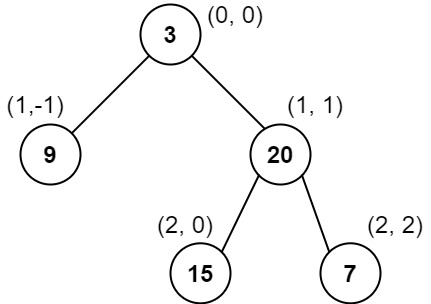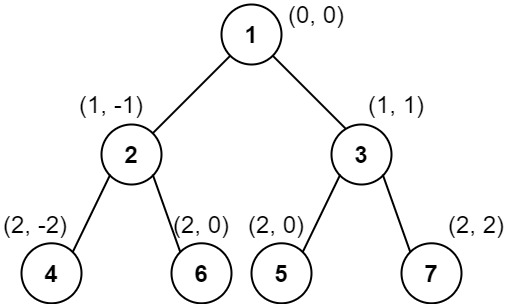987. Vertical Order Traversal of a Binary Tree
1. Question
Given the root of a binary tree, calculate the vertical order traversal of the binary tree.
For each node at position (row, col), its left and right children will be at positions (row + 1, col - 1)and(row + 1, col + 1)respectively. The root of the tree is at(0, 0).
The vertical order traversal of a binary tree is a list of top-to-bottom orderings for each column index starting from the leftmost column and ending on the rightmost column. There may be multiple nodes in the same row and same column. In such a case, sort these nodes by their values.
Return the vertical order traversal of the binary tree.
2. Examples
Example 1:

Input: root = [3,9,20,null,null,15,7]
Output: [[9],[3,15],[20],[7]]
Explanation:
Column -1: Only node 9 is in this column.
Column 0: Nodes 3 and 15 are in this column in that order from top to bottom.
Column 1: Only node 20 is in this column.
Column 2: Only node 7 is in this column.
Example 2:

Input: root = [1,2,3,4,5,6,7]
Output: [[4],[2],[1,5,6],[3],[7]]
Explanation:
Column -2: Only node 4 is in this column.
Column -1: Only node 2 is in this column.
Column 0: Nodes 1, 5, and 6 are in this column.
1 is at the top, so it comes first.
5 and 6 are at the same position (2, 0), so we order them by their value, 5 before 6.
Column 1: Only node 3 is in this column.
Column 2: Only node 7 is in this column.
Example 3:

Input: root = [1,2,3,4,6,5,7]
Output: [[4],[2],[1,5,6],[3],[7]]
Explanation:
This case is the exact same as example 2, but with nodes 5 and 6 swapped.
Note that the solution remains the same since 5 and 6 are in the same location and should be ordered by their values.
3. Constraints
The number of nodes in the tree is in the range [1, 1000].
0 <= Node.val <= 1000
4. References
- 来源:力扣(LeetCode) 链接:https://leetcode-cn.com/problems/vertical-order-traversal-of-a-binary-tree/ 著作权归领扣网络所有。商业转载请联系官方授权,非商业转载请注明出处。
5. Solutions
/**
* Definition for a binary tree node.
* public class TreeNode {
* int val;
* TreeNode left;
* TreeNode right;
* TreeNode() {}
* TreeNode(int val) { this.val = val; }
* TreeNode(int val, TreeNode left, TreeNode right) {
* this.val = val;
* this.left = left;
* this.right = right;
* }
* }
*/
class Solution {
public List<List<Integer>> verticalTraversal(TreeNode root) {
if(root == null){
return null;
}
// 用来保存树的节点
Queue<TreeNode> queue = new LinkedList<>();
// 用来保存纵坐标y
Queue<Integer> y = new LinkedList<>();
//两个平行队列
// 将根节点添加到队列中
queue.add(root);
// 设置根节点的纵坐标
y.add(0);
// 用map保存相同纵坐标的数
Map<Integer, List<Integer>> map = new HashMap<>();
while(!queue.isEmpty()){
// 队列的长度
int len = queue.size();
// 暂存
Map<Integer, List<Integer>> tmp = new HashMap<>();
for(int i = 0; i < len; i++){
// 将当前节点取出
TreeNode curr = queue.remove();
int currY = y.remove();
// 如果tmp中不存在currY对应的值,则new ArrayList
tmp.putIfAbsent(currY, new ArrayList<Integer>());
// 在对应y坐标的List中添加当前节点值
tmp.get(currY).add(curr.val);
// 判断当前节点的左右子节点是否为空,不为空则添加到队列中
if(curr.left != null){
queue.add(curr.left);
y.add(currY - 1);
}
if(curr.right != null){
queue.add(curr.right);
y.add(currY + 1);
}
}
// 遍历map
for(Integer key : tmp.keySet()){
map.putIfAbsent(key, new ArrayList<Integer>());
// 排序
Collections.sort(tmp.get(key));
map.get(key).addAll(tmp.get(key));
}
}
// 将map的键复制到list中并排序
List<Integer> list = new ArrayList<>(map.keySet());
Collections.sort(list);
// 根据排序好的键(即y值),将对应的List复制
List<List<Integer>> res = new ArrayList<>();
for(int key : list){
res.add(map.get(key));
}
return res;
}
}